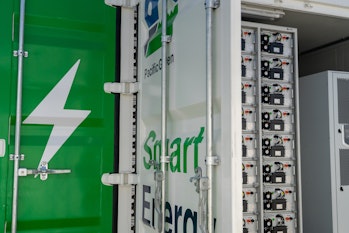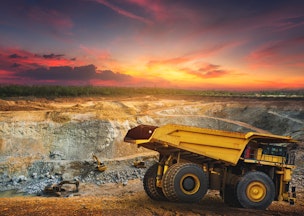The global mining industry is a major consumer of energy. And in the race to net zero emissions, the industry also looks set to become a major user of lithium-ion battery technology.
Integrating renewable energy into mining operations is key to reducing the sector’s greenhouse gas emissions, which are significant. According to a report by McKinsey & Company, mining is responsible for up to 7% of greenhouse gas emissions worldwide.
Reducing this footprint is not easy given the scale of the sector. The mining industry is immense, valued at almost US$2.2 trillion with predictions of nearly $2.8 trillion by 2027. Yet most mining operations are in remote, inhospitable locations.

Because of this, grid connections can be shaky, expensive or absent. Batteries are therefore essential to mining’s energy transition.
They can allow mine operators to store excess on-site generation from solar and wind and use it to power operations when energy demand is high, or when renewable sources are not available.
The mining industry can also benefit from batteries in other ways, for example using them as mobile power sources, back-up supplies and for microgrids, which can be independent of the grid and thus useful in more remote mining locations.
Beyond reducing carbon emissions and helping mining companies comply with environmental regulations, using batteries alongside renewable energy can lead to increased mine safety and productivity, with lower operating costs.
This is because the energy from renewables is effectively free once the capital costs of a project have been amortised. Compared to traditional diesel or gas generation, wind and solar plants with batteries are almost maintenance-free and are less prone to failures.
Andy Birtles, a fellow of the Institute of Materials, Minerals and Mining, says: “There is some incredible energy usage in mines, often in excess of 10 MW. Power can account for up to 40% of a mine’s costs, so anything that can bring down those costs will be a good thing.”
Mining is often viewed as a hard-to-abate sector where the move to low-carbon operations will be challenging. However, the sector has two strong motivations to rapidly embrace renewables and energy storage.
The first is that its operations could be among the worst affected by climate change. “Mining is no stranger to harsh climates; much of the industry already operates in inhospitable conditions,” says McKinsey.
“But forecasts of hazards such as heavy precipitation, drought and heat indicate these effects will get more frequent and intense, increasing the physical challenges to mining operations.”
Climate change could affect mining companies by flooding or reducing the supply of water to mines and by damaging nearby processing and transportation infrastructure, the consulting firm says.
Separately, mining companies have a vested interest in the energy transition because they will supply most of the raw materials for it.

In its 2021 report, Fostering Effective Energy Transition, the World Economic Forum explained that the “production of minerals such as graphite, lithium and cobalt could increase by nearly 500% by 2050 to meet the growing demand for clean energy technologies.”
Compared to fossil fuel-powered peers, low-carbon technologies such as electric vehicles and renewable energy plants need far greater amounts of minerals including aluminium and copper.
An electric car, for example, needs six times the amount of minerals required for an internal combustion engine vehicle, based on figures from the International Energy Agency.
Much of this materials demand will come from the kinds of batteries that could one day help power the mining sector.
The Western Australia-based Future Battery Industries Cooperative Research Centre is expecting demand for batteries to increase ninefold before 2030 as global decarbonisation accelerates.
“Securing adequate supplies will put pressure on the mining sector to redirect operations into new areas, to secure supply chains, and to do so while limiting the environmental impact,” says the World Economic Forum.
Switching to low-carbon operations is already high on the agenda of many mining corporations. Codelco, in Chile, uses solar power for one of its copper mines, while BHP has signed contracts for renewable energy at its Escondida and Spence copper mines, also both in Chile.
In Australia, the move to low-carbon mining operations could happen by default as the country edges away from fossil fuels. The Australian power system relies on coal for more than half of its electricity generation but many of its major plants are set to close down in the next 10 years.
AGL Energy has brought forward its coal closure plans by almost a decade while Origin Energy is looking to shut down the Eraring Power Station, in New South Wales, no later than 2025.
Batteries will play a large part in picking up the slack left by coal’s retirement from the energy system, with at least 250 battery plant projects reported to be in the works.
Lithium-ion batteries have emerged in recent years as the leading technology for grid-scale energy storage, thanks to their high energy density and high cycle capabilities.
Their costs are declining, which is attractive to mining companies that must contend with the low profit margins that come with commodity trading.
Further cost reductions in lithium-ion are expected to come from rising volumes of electric vehicles, which now account for around 10% of car sales globally.
Sales of electric vehicles in Europe have overtaken diesel vehicles, and now make up 20% of shipments in the region, compared to 15% in China and 5% in the US. Globally, there are predictions for 21 million electric vehicles on the road by 2030, up from 4 million in 2019.
Demand from the automotive industry means the future of the lithium-ion battery is assured, and its use in large-scale energy storage applications has already been put to the test in Australia, which has some of the biggest projects in the world.
It is our energy storage technology of choice at Pacific Green—and one we expect to use in projects across Australia. Including, of course, ones relating to the country’s economically vital mining sector.
Publish date: 15 May, 2023